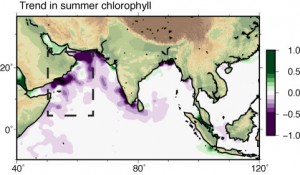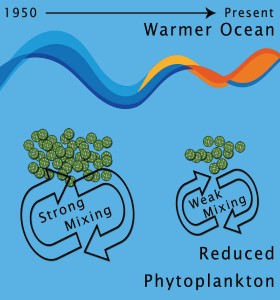21 January 2016
Rapid warming over the Indian Ocean reduces marine productivity
Posted by Nanci Bompey
By Roxy Mathew Koll
Roxy Mathew Koll is a climate scientist at the Indian Institute of Tropical Meteorology in Pune, India, and lead author of the new study, “A reduction in marine primary productivity driven by rapid warming over the tropical Indian Ocean” that was recently published online in Geophysical Research Letters.
Increasing water temperatures in the Indian Ocean are taking a toll on the marine ecosystem, according to our new study.
Almost 90 percent of the extra heat generated by increased greenhouse gases in the atmosphere has been absorbed by the oceans. Among tropical oceans, ocean warming is most prominent in the Indian Ocean. Now, a new study by me and my colleagues suggests rapid warming in the Indian Ocean reduced marine phytoplankton up to 20 percent during the past six decades.
Such a decline in the marine phytoplankton may cascade through the food chain, potentially turning this biologically productive region into an ecological desert. It may also impact food security in the Indian Ocean rim countries and also the global fisheries market.
Primary production

Marine phytoplankton in the tropical oceans 1998 to 2007. Red indicates large concentrations. From Behrenfeld et al., 2006.
Credit: American Geophysical Union
Almost all life on Earth is directly or indirectly dependent on primary production, whereby organic compounds are produced through photosynthesis.
Marine phytoplankton – microscopic plants in the ocean — generate half of the primary production globally. These phytoplankton sustain the aquatic food web, drive the marine ecosystem, and constrain the global fisheries catch. In addition, phytoplankton absorb solar radiation and modulate the upper ocean heat flux, thereby influencing climate processes and biogeochemical cycles, particularly the carbon cycle.
The Indian Ocean hosts one of the largest concentrations of phytoplankton blooms in the summer. Strong monsoonal winds lead to ocean upwelling, supplying nutrients from the subsurface to the surface, and supporting elevated rates of primary productivity.
Large-scale distribution of tuna and other fish are associated with the phytoplankton availability and abundance. The Indian Ocean accounts for 20 percent of the total tuna catch, especially the most economically valuable bigeye tuna, making it the second largest supplier of this fish to world markets, according to the Food and Agriculture Organization of the United Nations.
Ocean warming

Surface warming in the tropical oceans 1950 to 2012. Red indicates strong warming.
Credit: American Geophysical Union
The area of the Indian Ocean with the largest phytoplankton concentration is also the region which exhibits the largest ocean surface warming. Ocean warming in the Indian Ocean increased up to 1.2 degrees Celsius during the past century, compared to a global ocean surface warming of up to 0.8 degrees Celsius during the same time period.
However, due to the lack of long-term data, earlier studies were unable to extract the impact of the rapidly warming Indian Ocean. Our new research extends the study period using data from multiple satellite sensors, and also historical simulations from climate models.
Historical simulations indicate marine phytoplankton decreased by up to 20 percent during the past six decades. Recent satellite data show a decline in phytoplankton in the western Indian Ocean of up to 30 percent during last 16 years.

Trend in marine phytoplankton in the Indian Ocean 1998 to 2013. Purple indicates a significant decline.
Credit: American Geophysical Union
The decline in phytoplankton is likely a result of less mixing of subsurface and surface water due to warmer ocean temperatures. Rising ocean surface temperatures result in less dense water on the surface and more dense water in the subsurface, known as stratification. Such a stratified condition inhibits the vertical mixing of subsurface waters, which are usually nutrient rich, to the surface. The vertical mixing is a critical process for introducing nutrients into the upper zones where sufficient light is available for photosynthesis, leading to phytoplankton blooms.
Climate models suggest the Indian Ocean will continue to warm under increasing greenhouse gases. Our study indicates a further decline in phytoplankton in the Indian Ocean, suggesting the vulnerability of the marine ecosystem.
Impact on fisheries

Illustration of the decline in phytoplankton due to a warming Indian Ocean. The decline in phytoplankton is likely a result of less mixing of subsurface and surface water due to warmer ocean temperatures.
Credit: Roxy Mathew Koll
Available data show tuna catch rates in the Indian Ocean have declined by 50 to 90 percent during the past five decades. Increased industrial fisheries is a major cause for such a huge decline. However, the reduced phytoplankton may add a potential stress factor to this already declining resource.
A 20 to 30 percent reduction in phytoplankton does not necessarily translate into an equivalent reduction of fish, according to Marcello Vichi, professor of oceanography at the University of Cape Town, South Africa, and a co-author of the study. Tuna prey mostly on crustaceans, mollusks and smaller fish, which consume planktonic organisms that are more directly linked to the availability of nutrients in the ocean. However, tuna larvae prey on zooplankton that are directly dependent on phytoplankton, he said.
A decline in fisheries in this area could affect developing countries in South Asia and Africa, and also make it difficult to meet the demand from the global fisheries market, especially from Japan, the United States and Europe.
“The Indian Ocean appears to be a great challenge not only for humans since the monsoon is decreasing as the Indian Ocean is warming but may be so for living marine resources as well since the bottom of their food chain is also weakening,” said Raghu Murtugudde, professor of atmospheric and oceanic science at the University of Maryland, and a co-author of the new study. “The Indian Ocean must thus be monitored closely for clues about the response of the marine ecosystems in the rest of the world oceans.”
“The geopolitical and food security issues also could be important since some of the rim countries like Somalia have been experiencing political instability for some time and a collapse of fisheries in the region could only exacerbate the regional instabilities,” he added.










 GeoSpace is a blog on Earth and space science, managed by AGU’s Public Information staff. The blog features posts by AGU writers and guest contributors on all sorts of relevant science topics, but with a focus on new research and geo and space sciences-related stories that are currently in the news.
GeoSpace is a blog on Earth and space science, managed by AGU’s Public Information staff. The blog features posts by AGU writers and guest contributors on all sorts of relevant science topics, but with a focus on new research and geo and space sciences-related stories that are currently in the news.